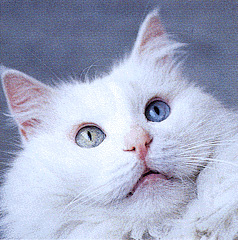

Custom Search
|
| Turkish Angora |
|---|

An odd-eyed Turkish Angora
|
| Alternative name |
| Ankara Cat |
| Country of origin |
| Turkey |
| Breed standards (external links) |
| ACFA, CFA, CCA, TICA, FIFe |
The Turkish Angora (Turkish: Ankara Kedisi) is a breed of domestic cat. Turkish Angoras are one of the ancient, naturally-occurring cat breeds, having originated in central Turkey, in the Ankara region.
They mostly have a white, silky, medium-long length coat, no undercoat and fine bone structure. There seems to be a connection between Ankara Cats and Persians (see below), and the Turkish Angora is also a distant cousin of the Turkish Van. Although they are known for their shimmery white coat, currently there are more than twenty varieties including black, blue, reddish fur. They come in tabby and tabby and white, along with smoke varieties, and are in every color other than pointed, lavender, and cinnamon (all of which would indicate breeding to an outcross).
Eyes may be blue, green or amber, but it is often a combination of one blue and one amber. The W gene responsible for white coat and blue eye is closely related to the their hearing ability, and presence of a blue eye can indicate the cat is deaf to the side the blue eye is located. However, a great many blue and odd-eyed whites have normal hearing, and even deaf cats lead a very normal, if indoor, life.
Ears are sharp and relatively bigger, head is long and wide. Another characteristic is the tail, which is kept parallel to the back.
Turkish Angora is an intelligent, adorable and very curious breed, very active throughout their life-span. Angoras love to bathe with their owners (another link to the cousin Turkish Van cat, which is known as the swimming cat ). They also tend to bond with their owners and try to be the center of attention, often doing their part in conversations. They usually don't like to be held for long, but like to stay in human presence, happily playing for hours.
Turkish Angoras are also very fond of high places, such as the tops of doors and bookshelves. Owners of Turkish Angoras should be careful to avoid letting electrical wires dangle out in the open. The Angora will chew them with their exceptionally sharp teeth. Turkish Angoras are also known to run the household by supervising every activity of their owner.
Like many domestic cats, it is likely that Turkish Angora descended from the African wildcat and led the way to Persian cats. The mountainous regions of Turkey allowed for confinement of the long haired breeds like Turkish Van Cat and Turkish Angora, and it is reported by French biologist de Buffon that long-furred cats have originated in Asia Minor.
Longhaired cats were imported to Britain and France from Turkey, Persia and Russia as early as the late 1500s, though there are indications that they appeared in Europe as early as 1300s due to the Crusades. The Angora cat was recognized as a distinct breed in Europe by the early 1600s. Attempts to breed them outside Turkey yielded little success. One theory speaks about the strong negative electrical fields dominant in Central Anatolia, especially in Ankara.
In the early 1900s, the government of Turkey in conjunction with the Ankara Zoo began a meticulous breeding program to protect and preserve the pure white Angora cats with blue and amber eyes, a program that continues today. The zoo particularly prized the odd-eyed Angoras (cats with eyes of differing colors). Prophet Muhammad's Angora, Muezza, was reputed to be an odd-eyed cat. The Zoo has its own cat facility which houses both the Van cat as well as the Angora cat. According to Dr. Can Ersoy, a biologist working at the zoo, the Van cat is about to become extinct, but there is a great deal of work being done in eastern Turkey to try and stop this. At the zoo, the Angora cat is kept under strict supervision, and kittens are sold only to people who can provide them with a good home environment.
The Angora cat, which was brought to the United States in 1955, was accepted for pedigree. Most longhaired cats are descended from the Angora, and the Persian is the result of selective breeding with Angora cats. In 1970, the CFA was the first U.S. registry to accept the Turkish Angora for registration. In 1973, the CFA accepted the Angora for Championship, but until 1978 only pure white Angoras were registrable. Today, all North American registries accept the Turkish Angora. While numbers are still small, the gene pool is growing, with the registration totals gaining ground each year.
Turkish Angora Cat F.A.Q.
Information from breedlist.com
T.A.B.U. Turkish Angora Breeder's Union
CFA's Breeder Referral List
Cats, made by MultiMedia | Free content and software
This guide is licensed under the GNU Free Documentation License. It uses material from the Wikipedia.